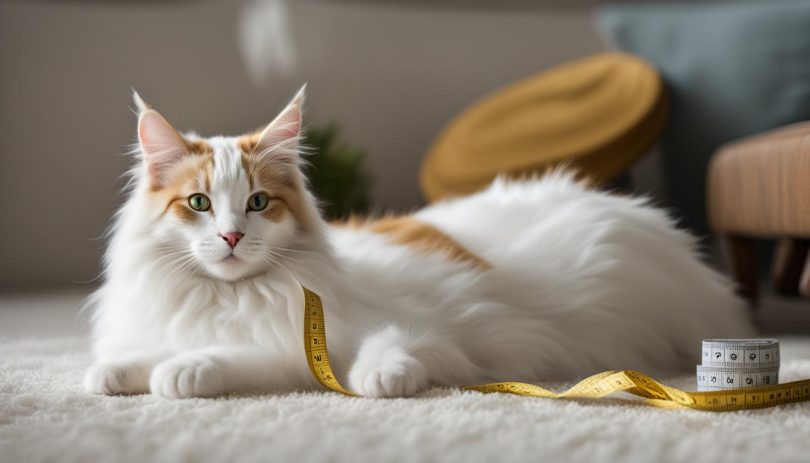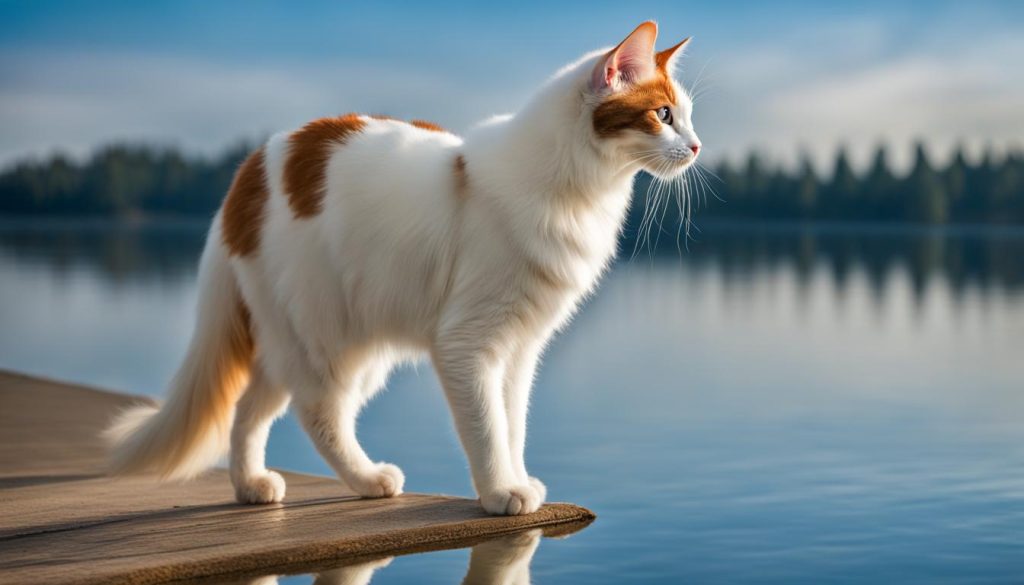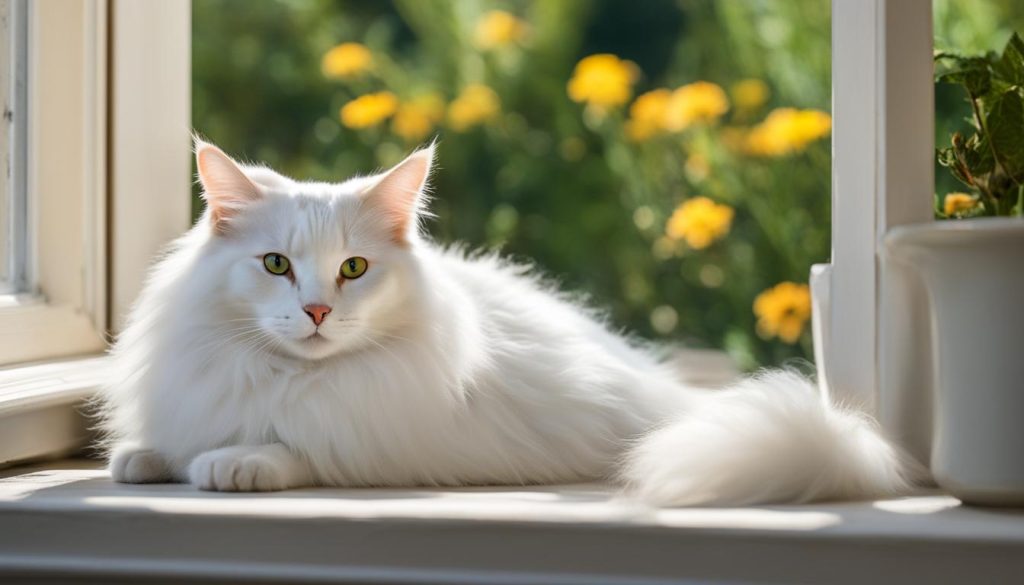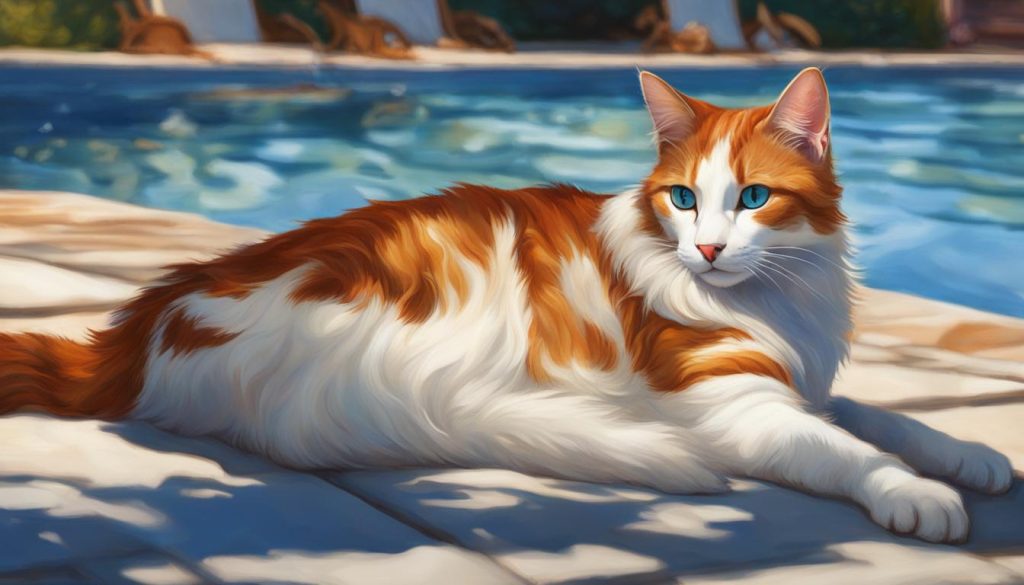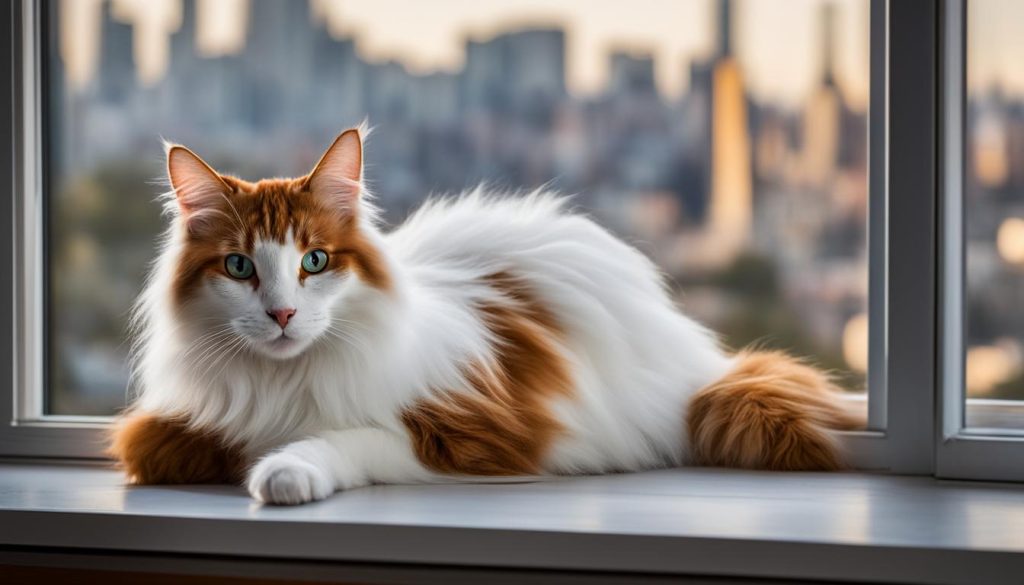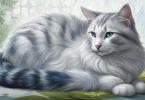Are you curious about the size of Turkish Van cats? As a cat lover and enthusiast, I have always been fascinated by the various sizes and breeds of cats. Turkish Van cats, in particular, have caught my attention with their unique characteristics and playful demeanor.
Turkish Van cats are medium to large in size, with males typically being larger than females. It takes them three to five years to reach their full size and weight. The average weight for a healthy male Turkish Van cat is between 10 to 20 pounds, while females typically weigh between seven to 12 pounds. These cats have sturdy torsos, strong legs, and moderate boning, making them appear larger than some other cat breeds.
The length and height of Turkish Van cats can also vary. They have relatively large heads, wedge-shaped and topped by large ears. This gives them a distinctive appearance that adds to their overall size. Their coats are semi-long and mostly white, with coloration on their heads and tails. It’s worth noting that Turkish Van cats also have distinct eye colors, including blue, amber, or odd eyes.
Key Takeaways:
- Turkish Van cats are medium to large in size, with males being larger than females.
- Healthy male Turkish Van cats can weigh between 10 to 20 pounds, while females typically weigh between seven to 12 pounds.
- They have sturdy torsos, strong legs, and moderate boning, giving them a larger appearance.
- Turkish Van cats have relatively large heads, wedge-shaped and topped by large ears.
- Their coats are semi-long and mostly white, with coloration on their heads and tails.
- Turkish Van cats can have blue, amber, or odd eyes, adding to their unique appearance.
The Origins and History of Turkish Van Cats
Turkish Van cats have a fascinating heritage that dates back to ancient times. These majestic felines originated in Eastern Turkey, particularly in the region surrounding Lake Van. Their unique characteristics and affinity for water have captivated people for centuries.
The discovery of Turkish Van cats as a distinct breed is believed to have occurred during the Middle Ages. They were treasured by the people living in the Lake Van region, who recognized their exceptional swimming abilities. The cats’ love for water became a defining trait that set them apart from other breeds.
“The Turkish Van cats’ swimming abilities and love for water intrigued people for centuries. They were considered a special breed in their native land.”
It wasn’t until the 1950s that the rest of the world became aware of Turkish Van cats and their unique characteristics. Two British women, Laura Lushington and Sonia Halliday, discovered the breed’s affinity for water while traveling in Turkey. They brought back two kittens, named White Smoke and Black Velvet, to England, which marked the introduction of Turkish Van cats to the Western world.
| Year | Significant Event |
|---|---|
| 1955 | The discovery of Turkish Van cats’ swimming abilities by Laura Lushington and Sonia Halliday |
| 1969 | The Turkish Van breed’s recognition by the Governing Council of the Cat Fancy |
| 1982 | The introduction of Turkish Van cats to the United States |
Despite their captivating qualities, Turkish Van cats remain relatively rare in the global cat population. Their scarcity adds to their allure, and finding one for sale can be challenging. The breed’s rarity is due in part to their historical association with the Lake Van region and the limited number of breeders.
The rich history and unique characteristics of Turkish Van cats make them a truly remarkable and sought-after breed. Their origins in Turkey and their journey to the Western world have contributed to their enduring appeal among cat enthusiasts and collectors.
The Unique Characteristics of Turkish Van Cats
Turkish Van cats possess a range of unique characteristics that make them truly special. From their distinct markings to their temperament and physical features, these cats stand out from other breeds.
First and foremost, Turkish Van cats are known for their eye-catching coat patterns. They have mostly white bodies with coloration on their heads and tails. The coloration can vary, ranging from red and brown to blue, cream, and black. This striking contrast adds to their overall allure and charm.
Aside from their captivating appearance, Turkish Van cats are also known for their loving and loyal temperament. They form strong bonds with their owners and enjoy spending time with them. These cats are affectionate and crave attention, making them wonderful companions.
In terms of size and physical features, Turkish Van cats are medium to large. They have sturdy torsos, strong legs, and relatively large heads. Their coats are semi-long and feel like cashmere to the touch. Additionally, Turkish Van cats can have blue, amber, or even odd eyes. The unique combination of their striking coat and eye colors adds to their individuality and beauty.
| Characteristics | Description |
|---|---|
| Coat | Semi-long, mostly white with coloration on head and tail |
| Temperament | Loving, loyal, and affectionate |
| Size and Physical Features | Medium to large, sturdy torsos, strong legs, and relatively large heads |
| Eye Color | Blue, amber, or odd eyes |
“Turkish Van cats possess a unique combination of striking coat and eye colors, making them truly captivating and beautiful.”
The Markings of Turkish Van Cats
The distinctive coat pattern of Turkish Van cats is known as “van pattern.” This term is used to describe the coloration on their head and tail, resembling a vanishing waterfall. The van pattern is unique to this breed and sets them apart from other cats.
- The van pattern on the head typically forms a color patch on one side or a split coloration with one eye surrounded by color.
- The van pattern on the tail is often a coloration at the base, which then fades or “vanishes” towards the tip.
This unique marking adds to the individuality and charm of Turkish Van cats, making them truly one-of-a-kind.
Caring for Turkish Van Cats
When it comes to caring for Turkish Van cats, there are a few key aspects to consider. Grooming is an important part of their care routine. While their semi-long coats are relatively low-maintenance, regular brushing is necessary to remove dead hair and keep their coats shiny. Additionally, dental care is crucial for their overall health, so regular teeth brushing and monitoring of their ears are important.
In terms of feeding, Turkish Van cats should be provided with a balanced diet that meets their age, energy level, and breed requirements. Adequate water intake is also essential to prevent dehydration, especially considering their affinity for water. Providing fresh water regularly and ensuring access to clean water sources is vital.
Turkish Van cats are active and intelligent, requiring regular exercise and mental stimulation. Interactive toys and play sessions can help keep them physically and mentally stimulated. Veterinary care is also essential to their well-being. Regular check-ups and preventive care can help identify and address any potential health problems early on.
| Grooming | Feeding | Exercise | Veterinary Care | Health Problems |
|---|---|---|---|---|
| Regular brushing to remove dead hair | Provide a balanced diet based on age and energy level | Regular exercise and play sessions | Regular veterinary check-ups | Respiratory issues, cancer, diabetes |
| Dental care and monitoring of ears | Adequate water intake to prevent dehydration | Interactive toys for mental stimulation | Preventive care for overall health | Regular check-ups for early detection |
While Turkish Van cats are generally healthy, they can be prone to certain health problems such as respiratory issues, cancer, and diabetes. Regular veterinary visits can help ensure their well-being and catch any potential issues early on. By providing proper grooming, feeding, exercise, and veterinary care, you can help your Turkish Van cat live a happy and healthy life.
Introducing Turkish Van Cats to Your Family
Turkish Van cats are known for their unique characteristics and personalities, which can greatly influence their behavior when introduced to other pets and children. While these cats can generally get along well with other animals, they have a strong inclination for asserting dominance in the household. This means that if you already have pets, it’s important to monitor their interactions and establish boundaries to ensure a harmonious environment.
When introducing Turkish Van cats to other pets, such as cats or dogs, it’s crucial to do so gradually and under controlled circumstances. Start by isolating the new cat in a separate room to allow them to acclimate to their new surroundings. Then, slowly introduce them to the other pets, monitoring their reactions. Provide plenty of positive reinforcement, treats, and toys to create positive associations. Additionally, ensure that each pet has their own space and resources to prevent territorial conflicts.
When it comes to children, Turkish Van cats may not be the best match for households with young kids. These cats may not appreciate rough handling, so it’s important to educate children about the cat’s boundaries and teach them how to interact with the cat in a gentle and respectful manner. It’s advisable to wait until children are old enough to understand and respect the cat’s needs before bringing a Turkish Van cat into the family.
Socialization is a crucial aspect of integrating Turkish Van cats into your family. Expose them to different environments, sounds, and experiences from a young age to help them become well-rounded and adaptable cats. This can include supervised outdoor exploration, meeting new people, and exposure to various stimuli. By providing a positive and enriching environment, Turkish Van cats can thrive and form strong bonds with their human family members.
Table: Turkish Van Cat Behavioral Considerations
| Behavior | Considerations |
|---|---|
| Interaction with Other Pets | Monitor introductions, establish boundaries, provide positive reinforcement |
| Interaction with Children | Educate children on gentle handling, wait until they are old enough to understand boundaries |
| Socialization | Expose to various environments and stimuli from a young age to promote adaptability |
By considering the unique behavioral traits of Turkish Van cats and taking the necessary steps to introduce them to your family, you can create a harmonious living environment for both the cat and your existing pets or children. With patience, proper socialization, and understanding, Turkish Van cats can thrive and become cherished members of your family.
The Popularity and Rarity of Turkish Van Cats
Turkish Van cats have gained significant popularity in recent years, thanks to their stunning coat, playful demeanor, and intriguing personality. These unique felines have captured the hearts of cat lovers worldwide, drawing attention to their distinct characteristics.
However, despite their growing popularity, Turkish Van cats remain relatively rare. Finding a Turkish Van cat for sale can still be quite challenging, and potential owners may need to invest considerable effort in their search. Some enthusiasts even travel to the breed’s homeland, Turkey, to acquire these captivating cats.
To highlight the rarity of Turkish Van cats, let’s take a closer look at their availability:
| Availability | Description |
|---|---|
| Popularity | Due to their unique characteristics, Turkish Van cats have gained popularity among cat enthusiasts and breeders. |
| Rarity | Despite their increasing popularity, Turkish Van cats are still relatively rare compared to more common breeds. |
| Availability | Finding a Turkish Van cat for sale can be a challenging task, requiring extensive research and potentially traveling to Turkey. |
| Breed Recognition | The Turkish Van breed has gained recognition from various cat associations, including the Cat Fanciers’ Association and The International Cat Association. |
As the demand for Turkish Van cats continues to grow, it becomes increasingly important to support responsible breeding practices and ensure the preservation of this remarkable breed for future generations.
Understanding the Turkish Van Cat’s Fascination with Water
The Turkish Van cat’s love for water is one of its most fascinating and distinctive traits. Unlike most cats, Turkish Vans are not afraid to get wet and actually enjoy playing in water. Whether it’s a faucet, a bowl, or a puddle, these cats are drawn to water sources and have a natural affinity for aquatic activities.
Swimming is a behavior that sets Turkish Van cats apart from other breeds. They have a unique ability to swim, which is highly unusual for felines. Their water-resistant fur enables them to glide through the water with ease. This love for swimming is believed to have developed in the breed’s ancestral home around Lake Van in Turkey, where the cats had ample exposure to water.
Owners of Turkish Van cats should be prepared for their pets’ water-related behaviors. These cats may be found splashing in their water bowls, playing with dripping faucets, or even joining their humans in the bathtub or swimming pool. Their curiosity and fearlessness around water make them a truly remarkable and entertaining breed.
Although Turkish Van cats’ fascination with water can be endearing, it’s important for owners to take precautions to ensure their safety. Limiting their access to water sources and providing appropriate supervision is essential to prevent accidents and keep your adventurous feline friend content.
The Turkish Van Cat’s Love for Water
The Turkish Van cat’s affinity for water is an extraordinary characteristic that sets this breed apart from others. Unlike most cats, Turkish Vans are not afraid to get wet and are even known to engage in swimming. This love for water is believed to have developed in their ancestral home around Lake Van, where they had frequent exposure to aquatic environments.
Owners of Turkish Van cats may witness their pets engaging in a variety of water-related behaviors. These cats are often drawn to water sources, such as faucets and bowls, and may enjoy playing with dripping water or splashing in their bowls. Some Turkish Van cats may even attempt to join their humans in the bathtub or swimming pool.
While their fascination with water can be entertaining, it’s important for owners to ensure their cats’ safety. Supervision and controlled access to water sources are crucial to prevent accidents. Additionally, providing alternative outlets for their water-related behaviors, such as interactive toys or shallow water containers, can help satisfy their curiosity and keep them engaged.
Table: Turkish Van Cat Water-Related Behaviors
| Water-Related Behaviors | Description |
|---|---|
| Playing with water | Turkish Van cats may engage in games with dripping faucets, splash water with their paws, or playfully bat at water in their bowls. |
| Swimming | Unlike most cats, Turkish Vans have a natural ability to swim. They may enjoy swimming in pools, bathtubs, or bodies of water. |
| Investigating water sources | Turkish Van cats are curious about water and may explore sinks, toilets, or any water-related areas in the household. |
| Paw dipping | These cats may dip their paws in water and then lick them, possibly to cool down or satisfy their curiosity. |
Understanding and embracing the Turkish Van cat’s love for water can enhance the bond between owners and their feline companions. Providing safe opportunities for water-related play and exploration can keep these remarkable cats entertained and content in their homes.
The Future and Preservation of the Turkish Van Breed
Turkish Van cats are a unique and captivating breed that requires dedicated breeders to preserve their distinct characteristics. These breeders play a crucial role in ensuring the continuation of the Turkish Van breed and maintaining its breed standards. The preservation of the Turkish Van breed involves careful selection of breeding pairs to produce offspring that possess the desired physical features and temperament.
There are reputable Turkish Van breeders who adhere to these standards and prioritize the health and well-being of their cats. These breeders are knowledgeable about the breed’s history and traits, and they take pride in raising healthy and well-socialized Turkish Van kittens.
Breed associations, such as the Governing Council of the Cat Fancy, also contribute to the preservation of the Turkish Van breed. These associations provide guidance and support to breeders, set breed standards, and organize cat shows and competitions that showcase the beauty and uniqueness of Turkish Van cats.
The Future of the Turkish Van Breed
The future of the Turkish Van breed depends on the continued interest and appreciation for these remarkable cats. As more people become aware of the Turkish Van breed and its special qualities, the demand for these cats may increase. However, it is essential that potential owners do thorough research and choose reputable breeders who prioritize the welfare of their cats.
By respecting and promoting responsible breeding practices, supporting breed associations, and educating the public about the Turkish Van breed, we can ensure that future generations will have the opportunity to enjoy the companionship of these extraordinary feline friends.
Turkish Van Cat Breed Standards
| Physical Features | Temperament |
|---|---|
| Sturdy torsos | Loving and loyal |
| Strong legs | Enjoy attention and playtime |
| Large heads | Mischievous side |
| Semi-long coat | May assert dominance |
| Coloration on head and tail | Friendly with strangers |
| Blue, amber, or odd eyes | May not tolerate being picked up or held for long periods |
Conclusion
Turkish Van cats are a remarkable and captivating breed. Their size, unique coat patterns, love for water, and playful personalities make them stand out among other cat breeds. Their medium to large size, sturdy torsos, and strong legs give them a distinct appearance. With their semi-long, mostly white coats and coloration on their heads and tails, Turkish Van cats are truly stunning.
One of the most fascinating traits of Turkish Van cats is their love for water. They enjoy playing with water and are even known to swim, which is quite uncommon among cats. Their water-resistant fur allows them to indulge in water activities without any trouble.
While Turkish Van cats may be rare and require some special care, they can make wonderful companions for those who appreciate their distinct characteristics. It is important to consider their needs and traits before adding one to your family. With their loving and loyal temperament, Turkish Van cats can bring joy and entertainment to your home. Embrace the rewarding experience of living with these extraordinary feline friends, and enjoy the unique qualities that make Turkish Van cats so special.
FAQ
How big do Turkish Van cats get?
Turkish Van cats are medium to large in size. Healthy males can weigh between 10 to 20 pounds, while healthy females weigh between seven to 12 pounds.
What is the average size of Turkish Van cats?
Turkish Van cats can take three to five years to reach full size. Males are generally larger than females.
What is the lifespan of Turkish Van cats?
Turkish Van cats have an average lifespan for cat breeds, living up to 12 to 17 years.
What is the coat pattern of Turkish Van cats?
Turkish Van cats have a mostly white coat with coloration on their heads and tails. The coloration can vary, including red, brown, blue, cream, and black.
What are the unique characteristics of Turkish Van cats?
Turkish Van cats have sturdy torsos, strong legs, relatively large heads, and distinctive eye colors. They are known for their loving and loyal temperament.
How should I groom a Turkish Van cat?
Turkish Van cats are relatively easy to groom. They require occasional brushing to remove dead hairs and should receive dental care. Regular bathing is not necessary.
How should I care for the health of a Turkish Van cat?
Turkish Van cats should have regular veterinary visits to ensure their overall health. They are generally healthy but can be susceptible to respiratory issues, cancer, and diabetes.
Are Turkish Van cats suitable for households with other pets?
Turkish Van cats can get along well with other pets, including other cats and dogs. However, they may assert dominance and prefer to be in charge.
Can Turkish Van cats be around young children?
Turkish Van cats are generally not suitable for households with young children, as they may not appreciate rough handling. It is important to introduce children to the cat’s boundaries and ensure they are old enough to understand and respect them.
How rare are Turkish Van cats?
Turkish Van cats remain relatively rare worldwide. Finding one for sale may require significant effort and possibly travel to Turkey.
What is the fascination of Turkish Van cats with water?
Turkish Van cats have a unique love for water and are known to swim. They have water-resistant fur and enjoy playing with water from various sources.
How can I contribute to the preservation of the Turkish Van breed?
The future of the Turkish Van breed relies on responsible breeding practices and the continued interest and appreciation for these cats. Support breeders and breed associations that work to preserve and promote the breed’s unique characteristics.
